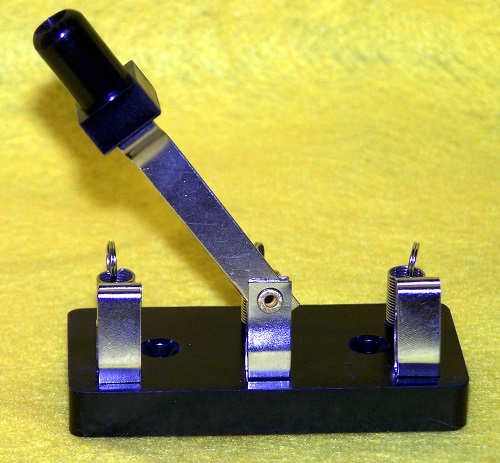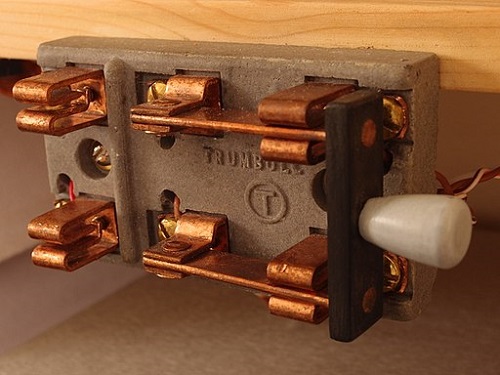Difference Between SPDT and DPDT

Single Pole Double Throw Switch
SPDT vs. DPDT
“SPDT” stands for “single pole double throw,” while “DPDT” stands for “double pole double throw.” Both terms are varieties of switches.
A switch, in a mechanical and electrical setting, is a control device that is used to establish or interrupt the flow of power or electricity into a circuit. The circuit is often composed of a switch, wiring, and receptacles for the appliance. The power flows to the circuit and, finally, powers the appliance attached to the circuit.
A pole refers to the number of circuits or wires that a switch controls. A single pole will switch one wire by opening, closing, or changing the connection in a single conductor, while a double pole switch will control (by closing and opening) two separate wires or circuits at the same time.
A throw, like a pole, can be single or double. A single throw means that a switch opens, closes, or completes a circuit at only one of the extreme positions, while a double throw does the same thing as the single throw, except that it completes a circuit at both positions of its actuator.
Both SPDT and DPDT are standard types of switches. SPDT, also called a changeover switch, is a two-position with an ON-ON switch. It switches one line into two different ways. There is a common terminal in place that is connected to one of the two switched terminals. In this kind of switch, both devices on the terminals cannot be in use at the same time, because only one is to be energized at a time. One appliance will be on while the other appliance connected to the switch is off.
The SPDT has two circuits with two choices of “ON.” This also makes SPDT a two-circuit mechanism.

DPDT knife switch in closed position
On the other hand, DPDT is basically two SPDTs together on the same switch. It is a dual ON-ON kind of switch derived from the characteristics of SPDT. A DPDT switch usually has two (ON-ON) or three (ON-OFF-ON) positions.
The pair of SPDT switches operates together with four circuits with two independent circuit systems. The circuits can be switched on at the same time. In this situation, both appliances in the same circuits will be powered when the switch is on. Meanwhile, in a DPDT’s four circuits, only two circuits can be energized at the same time. The DPDT utilizes polarity reversal that allows it to simultaneously handle two energized circuits.
An advantage of DPDT is that it can be used in different applications. With a DPDT switch, one can turn on an appliance and turn off another at the same time with just one flick.
Additionally, the SPDT switch has three pins or terminals, while the DPDT has six.
Summary:
1.“SPDT” from its acronym spells out “single pole double throw,” while “DPDT” has the meaning of “double pole double throw.”
2.DPDT is a derived mechanism of SPDT; it’s basically two SPDTs in one circuit. Moreover, DPDT has four circuits compared to the two circuits of the SPDT.
3.An SPDT switch has two positions (ON-ON), while DPDT can have the two (ON-ON) to three (ON-OFF-ON) positions.
4.SPDT has three terminals, while DPDT has six.
5.An SPDT switch has only one circuit mechanism, while a DPDT has two.
6.DPDT is more advantageous than SPDT since it can turn on and turn off different appliances at the same time. The SPDT system can only accommodate and power one appliance at a time.
- Differences Between Fraternity And Sorority - January 8, 2014
- Differences Between Lucite and Plastic - January 7, 2014
- Differences Between Oil and Butter - January 6, 2014
Search DifferenceBetween.net :
1 Comment
Leave a Response
References :
[0]http://tech.txdi.org/electricalswitches
[1]https://commons.wikimedia.org/wiki/File:DPDT_knife_switch_in_closed_position.jpg

The post contradicts itself. It states, “A pole refers to the number of circuits or wires that a switch controls.” then states, “The SPDT has two circuits with two choices of “ON.” This also makes SPDT a two-circuit mechanism.”
The post also makes it seem like an SPDT switch cannot come in a ON-OFF-ON configuration when it states,”The SPDT has two circuits with two choices of “ON.”” and “On the other hand, DPDT is basically two SPDTs together on the same switch. It is a dual ON-ON kind of switch derived from the characteristics of SPDT. A DPDT switch usually has two (ON-ON) or three (ON-OFF-ON) positions.”
It has three choices for the SPDT, ON-OFF-ON.